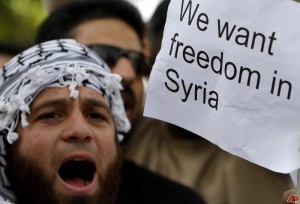 Syrian antigovernment activists, looking ahead to the Muslim holy month of Ramadan as an opportunity to intensify their monthslong effort to topple the regime of President Bashar al-Assad, protested in the thousands on Friday.
Syrian antigovernment activists, looking ahead to the Muslim holy month of Ramadan as an opportunity to intensify their monthslong effort to topple the regime of President Bashar al-Assad, protested in the thousands on Friday.
The government, in an effort to prevent such a shift in momentum, closed at least one mosque and on Friday deployed security forces in several cities in a crackdown that activists said killed at least 15 people.
Though protests have grown since they began five months ago, the opposition has struggled to attract the country’s elite or armed forces. Protests Friday were held under the banner, “Your silence is killing us,” to encourage more people to come out in opposition to the regime.
Activists see Ramadan as a potential tipping point. The month of fasting and contemplation will bring more of Syria’s Muslim majority to mosques— which have served as gathering points—creating new opportunities for escalated protests.
A sit-in has been planned in Damascus’s central Omayyeen Square on Monday, when Ramadan is expected to start here. So far only small antigovernment gatherings have been held in the center of the capital, where a large contingent of security forces deters protests.
“The government won’t be able to control all the demonstrations if people come out every night after extra prayers as we expect,” said Radwan Ziadeh, a U.S.-based human-rights activist from the Damascus suburb of Daraya. “Religious leaders will also speak out if the government continues to kill people.”
Over 1,500 people have been killed in the protests so far and thousands detained, according to opposition groups.
In another government effort to quell unrest, the cabinet this week offered two draft laws that state news agency Sana said completed a package of promised political overhauls. Opposition figures rejected the move, as the constitution still backs the supremacy of the ruling Baath party.
On Friday, security forces surrounded neighborhoods in the capital, in Homs, the nation’s third-largest city, and in Deraa, the southern town where protests started.
In the Damascus neighbourhood of Midan, security forces halted dawn prayers and blocked more worshippers from entering the al-Hassan mosque for main prayers according to residents and activists from the Local Coordination Committees, a network that has taken the lead in monitoring protests.
The 15 reported deaths Friday came when forces opened fire on protesters in the city of Deir el-Zour, which has been the focus of violence this week after reports of army defections, as well as Deraa and the coastal city of Latakia, activists said.
Large crowds also took to the streets in Hama, in towns in the province of Idleb, and in the suburbs of Damascus.
Protesters and observers said they feared that if protests intensify during Ramadan, the conflict could become more violent in some areas.
“Ramadan is being overhyped, but it could get more bloody in this period,” said a senior Western diplomat in the capital. “There will be more people out. The regime is weakened but is still able to fight.”
The persistence of the unrest in Syria has also increasingly brought new dimensions to the violence. Rights groups have reported fighting in Deir el-Zour between the military and defectors. Those reports couldn’t be independently verified.
On Friday, state news agency Sana described a bomb blast at a oil pipeline close to the town of Tel Kalakh as the work of unidentified saboteurs.
While protest leaders have promoted a message of nonviolence, some activists say they expect they will have to take up weapons if they want to dislodge the regime.
Leave a Reply
You must be logged in to post a comment.